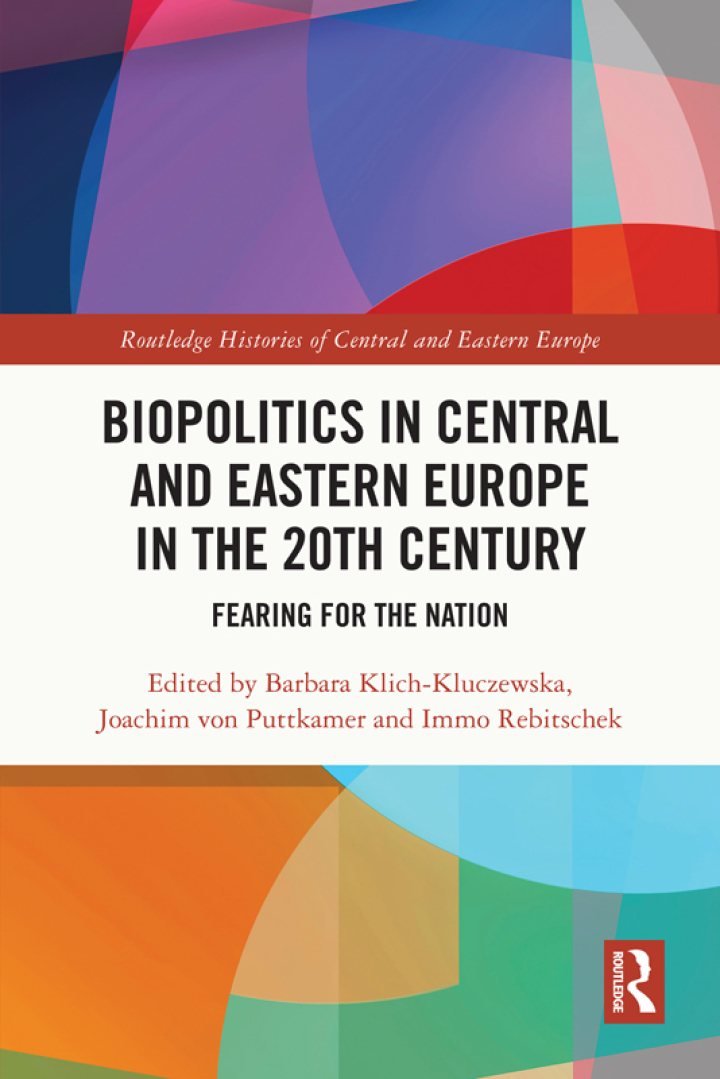Fear and biopolitics in East Central Europe

Published by: Routledge

Michel Foucault famously used the term biopolitics to denote the strategies that render not only the lives of individuals but also of larger collectivities into political questions, leading to decisions about whom to “make live” and whom to “let die.” The scholarly interest in the category of biopolitics in modern East Central Europe has been uneven so far. Surprisingly little attention has been paid to periods beyond the interwar years, which were marked by increasing biopolitical radicalism, and beyond the Second World War, when biopolitics reached its dark apogee in the spasms of Nazi violence. This useful volume, edited by Barbara Klich-Kluczewska, Joachim von Puttkamer, and Immo Rebitschek, seeks to remedy this gap by examining biopolitics in East Central Europe throughout the twentieth century. It offers a dozen empirically rich case studies, predominantly dealing with specific facets of biopolitics in individual countries of the region, covering time spans that range from the dissolution of the continental empires in the aftermath of the First World War to the collapse of the state socialist dictatorships roughly seven decades later.
Approaching biopolitics as a broad and varied landscape, this volume addresses themes such as food relief, disease and epidemic control, and pension systems, alongside and beyond the crucial issues of reproduction. This broad definition not only aligns with contemporary theorizing on biopolitics but also helpfully challenges the tendency in some scholarship on East Central Europe to narrow the analysis of biopolitics largely to eugenics and racial anthropology. This does not mean, of course, that eugenics is entirely absent from the volume: the very first case study addresses eugenics and race hygiene in early 20th-century Austria (Herwig Czech), while two other chapters shed light on the—also racializing, it should be emphasized—practices of typhus control in Poland (Łukasz Mieszkowski) and transnational food aid in Hungary’s capital (Friederike Kind-Kovács), both in the early post-First World War years. Yet most other case studies go far beyond eugenics and, notably, focus on the dictatorships that emerged across East Central Europe after the Second World War.
Perhaps counterintuitively, given the volume’s all-encompassing title, the analysis of biopolitics in state-socialist regimes constitutes its actual core. The volume contains studies dealing with regimes as varied as Yugoslavia (Ivana Dobrivojević Tomić), Romania (Corina Doboș), the German Democratic Republic (Malte Thießen, within the span of a more broadly conceived study), and Czechoslovakia (Jakub Rákosník and Radka Šustrová). However, the largest share of attention is devoted to historicizing biopolitics in Poland (Natalia Aleksiun; Agata Ignaciuk; Ewelina Szpak). This emphasis likely reflects the urgency posed by contemporary struggles for reproductive justice, also highlighted by the inclusion of a chapter on the biopolitics of Global Catholicism in the mid-20th century (Wannes Dupont). Taken together with other recent analyses of biopolitical practices in state-socialist regimes (such as the volume by Denisa Nešťáková, recently reviewed in the CEU Review of Books), the case studies in this volume signal a forcefully emerging trend in the historiography of East Central Europe.
a common thread runs through these case studies: they reveal that biopolitics in state-socialist countries such as Poland was not limited to blunt coercion. Rather, it employed a wide range of incentives, mobilization strategies, and persuasive tactics, including fear-inducing public campaigns.
It is all the more regrettable that the volume’s editors consciously made “no attempt to propose a conclusive definition of biopolitics” (p. 3) or to thoroughly engage with the available theoretical frameworks. While the text frequently, albeit somewhat vaguely, references Foucault, often relying on Thomas Lemke’s introduction to biopolitics, it conspicuously lacks direct engagement with the complex arguments of other key theorists—such as Giorgio Agamben, Roberto Esposito, Paul Rabinow, Nikolas Rose, and Achille Mbembe. Consequently, although some chapters explore Sergei Prozorov’s thought-provoking interpretations of the Stalinist Soviet Union through a biopolitical lens, the authors’ limited theoretical grounding hampers their ability to effectively utilize these interpretations or to articulate a clear position on socialist East Central Europe during and beyond its local Stalinisms. A crucial question remains unanswered: Did state-socialist regimes in East Central Europe practice a distinct form of biopolitics? While the volume presents numerous empirical examples of this socialist biopolitics, its decision to forego a robust theoretical framework unfortunately prevents it from providing a convincing conceptual answer.
Closely related to this is the somewhat disparate nature of the case studies, which primarily showcase the individual research interests of the contributors, as well as their blind spots. Strikingly, for instance, only one of the studies mentions the Roma people, and none dwells on the socialist countries’ ties to the Global South. Nonetheless, a common thread runs through these case studies: they reveal that biopolitics in state-socialist countries such as Poland was not limited to blunt coercion. Rather, it employed a wide range of incentives, mobilization strategies, and persuasive tactics, including fear-inducing public campaigns. Furthermore, rather than being simply imposed from above, biopolitical practices seem to have resulted from negotiations among various actors, including bureaucrats, experts, and their audiences. Even in the sphere of biopolitics, the theory of totalitarianism, with its emphasis on overarching coercion, thus proves to be an unreliable guide. Some contributors even go so far as to suggest that the presence of such “participatory,” “negotiable,” or “soft” aspects of biopolitics (p. 10) was the defining feature of biopolitics in state-socialist regimes of East Central Europe, setting them apart from other dictatorships. One might question whether this argument would withstand a more thorough comparative inquiry. As Nikolas Rose points out in his Politics of Life Itself, “it is clearly inadequate to mark the specificity of contemporary biopolitics by counterposing positive to negative policies, voluntary to compulsory measures, coercion, and persuasion. The specificity of the biopolitics of the first half of the twentieth century lies elsewhere: in the links established between population, quality, territory, nation, and race” (p. 62).
In an introductory essay by Barbara Klich-Kluczewska and beyond, the volume is adamant about biopolitics as an essentially modern phenomenon. The analysis thus spotlights the political modernity of the state-socialist regimes of East Central Europe through the lens of biopolitics. In doing so, the volume perhaps too harshly dismisses the possibility of pre-modern and non-Western manifestations of biopolitics, even though the latter have been increasingly discussed by theorists. This choice comes with its own pitfalls. For instance, it strikingly affects the periodization of the volume, which limits itself to the “short” twentieth century. In other words, biopolitics in the era that came after socialism and after modernity, on the one hand, is entirely left aside. On the other hand, the multiethnic landed empires of East Central Europe are also omitted, perhaps reflecting a tacit assumption – in a certain contradiction with contemporary scholarship – that these polities were un- or pre-modern. (The solitary exception is the chapter by Immo Rebitschek, which otherwise also departs from the rest of the volume by its emphatic post-imperial framing.)
Finally, and no less importantly, the volume culminates in a sweeping claim about the nature of biopolitics in 20th-century East Central Europe. Perhaps echoing the existing scholarship on eugenics and racial anthropology in the region, and extending its conclusions to the entire century, the volume contends that “it was a crucial feature that the primary focus was on the nation rather than the populace.” (p. 2) This is a plausible claim, of course, and will certainly prove true in many parts of the region at multiple historical junctures. But was it the case, say, in interwar Red Vienna, governed by the Austro-Marxists? To put it differently: while East Central Europe was undoubtedly a hotbed of nationalism, it was also a site where creative attempts to cognitively grasp its ethnocultural diversity took place in the multi-ethnic empires and beyond. East Central Europe produced numerous innovative and critical reflections about nationalism, as well as theoretical and political attempts to transcend it, such as theories of federalism or non-territorial autonomy. One can only wonder if this was not also the case in the field of biopolitics, broadly conceived. Did all biopolitical thinking in East Central Europe really limit itself to fearing for the nation, as the title suggests, or were there also attempts—albeit tentative and tragically unsuccessful—to go beyond its narrow confines?
Vojtěch Pojar recently obtained his PhD from Central European University in Budapest. His dissertation explores the transnational entanglements and diverging trajectories of eugenicists in the Habsburg Empire and its successor states. He has published articles in the Austrian Journal of Historical Studies, East Central Europe, European Review of History, and Střed/Centre. His most recent publication examines the interplay between the hunger crisis and eugenics discourses in the Habsburg Empire during the First World War.
